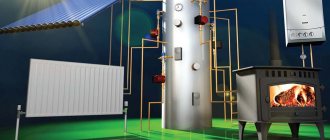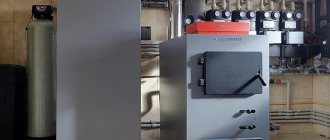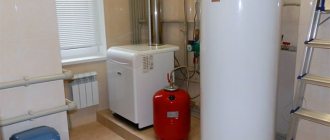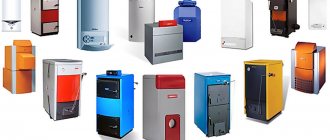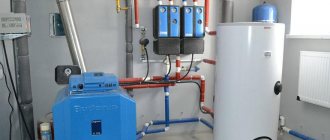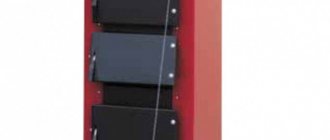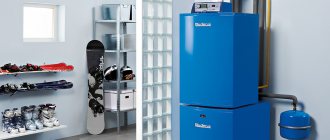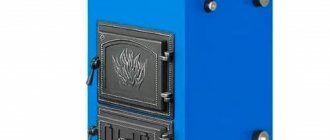If there is no central heating in a country house or cottage, the ideal solution for heating the home is a wood-electricity combination boiler. On the heating equipment market, about 70% of all models of heat generators designed for heating private homes are multi-fuel devices.
Combined devices are an excellent guarantee that with the onset of cold weather, the most comfortable temperature in the house will always be maintained, even if there are interruptions in the supply of one type of fuel. In addition, the necessary supply of firewood for the winter can be created in advance, and the availability of electricity in homes is not always stable, especially in bad weather.
What are the benefits of electric wood boilers?
The main fundamental disadvantage of any solid fuel boiler is that the homeowner is more or less tied to it.
After all, this device, unlike its gas counterpart, has to be “fed” only manually. This problem is partially solved in boilers with an automatic fuel supply system, but they can only work with fine-grained coal (with the size of individual parts from 5 to 25 mm), pellets or bulk fuel - shavings, wood chips or sunflower seed husks. If the owner of the house plans to use ordinary firewood as fuel, the automatic feeding system will not help him in any way. Boiler with automatic fuel supply system
On average, you have to add firewood to the boiler every three hours. What happens if you can't do it on time? Of course, the coolant in the heating system will cool down, and with it the air in the rooms. You will also have to forget about proper rest: you will have to get up at least twice during the night to replenish the supply of firewood, otherwise in the morning you will wake up in the refrigerator.
For the owner of a combination boiler that runs on wood and electricity, such problems can only be a nightmare. If the supply of firewood in the firebox is not renewed in a timely manner and the temperature of the coolant begins to fall, the smart automation itself will turn on the electric heating elements and the operation of the heating system will thus be resumed.
Another advantage of boilers of this type is that they are quite simple to manufacture and therefore relatively cheap. For those on a limited budget, such equipment is most suitable.
Separate boiler room
Advantages and disadvantages
It should be said that this category of devices has its disadvantages and advantages, which you should definitely pay attention to. If we talk about the advantages that such a combined boiler has, we should name:
If we talk about the advantages that such a combined boiler has, we should name:
- Long service life. If a boiler of this type is operated correctly, it will be able to perform its functions efficiently for at least 20 years.
- Autonomy. There is no point in monitoring the operation of such a boiler, since the automation installed in it will perfectly control its activity. Especially when it comes to working from a power outlet. Heating using heating elements is limited to the uninterrupted transmission of electrical energy.
- Smart design. Heat is distributed as efficiently and intelligently as possible, and energy losses will be very low, which makes these boilers an excellent and efficient solution.
- Economical. Electricity today is one of the most accessible types of energy, as is wood. As a solid fuel alternative, you can use coal or briquettes or pellets. In general, if we talk about efficiency, this boiler simply has no equal.
- Versatility. Such solutions are universal, because you can use any of the 2 types of fuel if desired.
But with all these advantages, combined solutions also have disadvantages. But any heating equipment has them, which is generally not surprising.
If we talk about the disadvantages, we should name:
- Large mass. Boilers that are made of cast iron weigh a couple of hundred kilograms, or even more. To install such a boiler, you must first make a concrete pad to strengthen the base of the floor. Due to the heavy weight of the device, there are no models that can be mounted on a wall. There are only solutions for floor mounting.
- Not a simple design. Combined options have a rather complex design, which leads to higher installation and maintenance costs.
- Low power of the electrical component. Typically, the power of electric heaters should not be greater than the power of the chamber where the firewood must be placed. The power of the firebox for firewood is usually from 6 to 25 kilowatts.
- Takes up a lot of space. As a rule, in order to install such a boiler, it is necessary to allocate a separate room for this - a boiler room, where fuel reserves should be stored.
Description of boiler operation
The heating elements are controlled by an electrical unit, and the intensity of solid fuel combustion is regulated by the air supply thermostat, opening the ash chamber damper with a chain at a certain angle. That is, the control functions of the electrical and solid fuel parts of the heater are separated. If air is forced into the firebox by a fan, then both parts are controlled by the automatic control system for the wood-burning boiler. In the first case, the operating algorithm is as follows:
After connecting the heat generator to the network, the electric heater is switched on. The temperature of the coolant is set on the control panel and the heating element begins to heat the water automatically. It is better to set the temperature 10-15 ºС below the working temperature.
At this time, fuel is loaded into the combustion chamber and it is ignited. From this moment on, heating of the coolant occurs together, unless the electric heaters are forcibly turned off.
Having reached the water temperature set on the remote control, the heating elements are turned off and the coolant is heated with wood until the operating temperature. The combustion intensity is controlled by a chain-driven thermostat, and as soon as the water reaches the operating temperature, it shuts off the air supply.
When the combination boiler burns its main fuel and there is no new loading, the coolant will begin to cool and at a certain moment the sensor of the electrical unit will work and it will turn on the heaters, which will maintain the water temperature until the next firewood is added.
The algorithm for working with an air supply fan and a single electronic unit is similar to that described above, only the process of setting up the equipment is simplified. In this case, the energy independence of the solid fuel part of the unit is lost.
Thanks to their design and operating principle, electric wood heating boilers for a private home acquire some advantages that are not typical of conventional solid fuel units:
- There is no condensation on the internal walls of the furnace due to the flow of cold water from the return pipeline, since the boiler tank is constantly heated by the heating element.
- As a result, the building heating system can be connected to the heat source directly, without organizing a small circuit and a mixing unit with a three-way valve.
- Theoretically, the efficiency of a combined water heater increases to 97-99% at a time when electric heating is operating and the main firebox is not functioning.
At the same time, the versatility of the unit does not eliminate the disadvantages inherent in both types of heaters separately. This is inertia, which is expressed in the inability to immediately stop heating the coolant when the maximum temperature is reached.
Another drawback is the relatively low power of the electrical part; a water jacket cannot significantly increase it; it is impossible to build many electric heaters into it. For this reason, the power of electric heaters is equal to the power of a wood combustion chamber in the range of 6-25 kW. If a higher indicator is required, then the electricity will only serve as heating and will be able to maintain the temperature of the coolant at a certain level.
What is more profitable - a separate electric boiler or a built-in heating element?
According to many experts, a separate electric water heater is better, since it only heats the system coolant, excluding heating the boiler water jacket. True, in some models, built-in heating elements are installed in the upper part of the heat generator housing, which completely solves the problem. In this case, the advantages of a multi-fuel device are obvious.
Installation of an electric wood-burning boiler
The design of heating boilers using wood and electricity is very simple. It consists of just a few elements:
1. Combustion chamber
It is located in the lower part of the boiler and has dimensions that allow you to lay firewood up to 600 mm long. The fuel is placed on a grate, under which an ash box is installed.
2. Heat exchanger with heating elements installed in it
The heat exchanger connected to the heating system is located above the firebox so that the hot gases generated during the combustion of wood blow over its surface.
3. A simple control unit
This component monitors the temperature of the coolant and, if necessary, supplies voltage to the electric heaters.
4. Housing and flue pipe
Heating element for boiler
The above list refers to the simplest version of an electric wood-burning boiler, but many of the modern models have various improvements. For example, the boiler can be equipped with an automatically controlled air damper, through which the control system doses the volume of air entering the combustion chamber and thus regulates the boiler power.
Double-circuit combined heating boilers are also more functional in comparison with the basic design. Such models have a second heat exchanger, which is connected to the hot water supply (DHW) circuit. This improvement eliminates the need for the home owner to purchase a separate heater for preparing hot water.
What should you pay attention to?
When selecting a model, you need to take into account several rules, failure to comply with which will lead to an error. As a result, the boiler may not be suitable for a particular home; for example, it may not be powerful enough and the room will be cold. For example, a device using wood or gas is dependent on the pressure in the main line, and when it decreases, it can give off noticeably less heat.
In addition to power, the technical specifications usually indicate the area of the house for which it is designed. The calculations are made by professionals and are quite accurate. You can use various tables found on the Internet
Particular attention should be paid to power when choosing the most universal options, such as a wood-gas-electricity device
It is worth considering a possible decrease in gas pressure in the line. This can significantly reduce the heating output. If there is no “reserve”, you will also have to use additional heaters powered by electricity. There is no point in heating with such characteristics; you will have to modernize it and incur additional costs.
The next stage is to determine the purpose of the combined boiler for heating. It can be purchased both as the main source of heat and for additional heating of running water, i.e. immediately choose the combined option.
Such a boiler is more profitable than a separate boiler, because wood or gas is already consumed for heating, and a separate water heater is usually powered by electricity. Wood heating often allows you to gain in the speed of reaching the desired temperature.
How to choose an electric wood-burning boiler?
Before purchasing a boiler of this type, you should decide on some of its parameters:
1. Boiler power
Power selection is carried out in the same way as for any other boiler. It is best to order a thermal calculation and heating system design from a specialized company. If this is not possible, you can use the average statistical value of the specific power of heating systems, which is 130 W / per square meter. m for houses with an area of 100 - 150 sq. m and 85 W/sq. m for houses with an area of 400 - 500 sq. m. By multiplying the specific power by the heated area, you can determine the required boiler power. So, for example, to heat a house with an area of 125 square meters. m you will need a unit with a power of 125x130 = 16,250 W or 16.25 kW.
We recommend reading: The length of the water heated floor circuit is the maximum and permissible for installing a heating system, how to calculate the length of the pipe, details in the photo and video
Do not forget that an electric wood-burning boiler places special demands on home wiring. Make sure that it will be able to “pull” the unit you like.
2. Weight
Devices of this type, especially powerful ones, are quite massive. Before purchasing a boiler, evaluate the load-bearing capacity of the floor and the possibility of strengthening its structure in the room where the boiler room will be located.
3. Material and design of the grate
If wood fuel predominates, you should choose a boiler with a cast iron grate. If you plan to use bulk fuel frequently, choose a model with a honeycomb grille, which is made of ceramic and steel.
4. Availability of a second heat exchanger
Today, a combined wood-electricity boiler with the ability to connect to a DHW circuit is a fairly popular product, but it is not suitable for everyone. The fact is that at the moment of using hot water, all the attention of the boiler switches to it. In this case, the heated coolant stops flowing into the heating system, since it is it that is used to heat water in the second heat exchanger. If for some needs you have to open the hot water tap for a long time, installing a double-circuit boiler does not make sense. In this case, you will simply be left without heating.
5. Heat exchanger material
Cast iron heat exchangers are considered the most preferred. They are not subject to corrosion, due to their high heat capacity they can smooth out short-term drops in boiler power and do not have weak points in the form of welding seams, since they are prefabricated. The steel heat exchanger is a welded structure, it is less durable and is susceptible to rust, but, unlike cast iron, it does not collapse under sudden temperature changes.
What you need to know when choosing a universal boiler
With all its versatility, one type of fuel should be the main one, and the boiler should be selected according to the type of main fuel. When purchasing an imported boiler, please note that the nameplate indicates the rated power, and not the maximum, as for Russian ones. Sellers usually also name the maximum power. For each type of fuel, a universal boiler will have different power.
Some examples of combination boilers.
Single-circuit universal boiler Zota Dymok KOTV-20M (Russia)
The boiler is designed to operate in water heating systems for residential and industrial premises.
Main characteristics:
- fuel wood/electricity;
- power 20 kW;
- circuit 1;
- type of installation: floor;
- heating area 140 sq. m;
- heat exchanger steel;
- Efficiency 70%;
- chimney 150 mm;
- weight 108 kg;
- dimensions 750x400x705 mm.
The cost of the boiler is 25,000 rubles.
According to reviews, inexpensive and reliable. Ideal for a country house and small production. The main advantages are simplicity, reliability and low price.
The photo shows the universal boiler Zota Dymok KOTV-20M
Single-circuit universal boiler Protherm Bizon 30 NL (Slovakia)
- gas and diesel power 27.1 kW;
- fuel - natural and liquefied gas, diesel fuel and fuel oil;
- open camera;
- heat exchanger cast iron;
- number of sections – 2;
- connecting a DHW boiler is possible;
- chimney diameter 150 mm;
- weight 121 kg;
- dimensions 870x450x385 mm.
The cost of the boiler is 41,300 rubles.
Reviews about the unit are positive. Buyers like the efficiency of the boiler. Heats up quickly and holds heat well. Some customers note difficulties in selecting a burner for this model.
The photo shows the universal boiler Protherm Bizon 30 NL
Combination boiler Ferroli Atlas 32 (Italy)
Designed to heat water below its boiling point at atmospheric pressure. Digital interface, microprocessor. Frost protection, remote control, room thermostat.
Characteristics:
- fuel natural gas, diesel fuel;
- gas power 30 kW;
- diesel power 30 kW;
- heat exchanger cast iron;
- combustion chamber is open;
- connecting a hot water boiler;
- chimney 100 mm;
- weight 127 kg;
- dimensions 850x500x400 mm.
Cost 54,100 rubles.
According to customer reviews, the boiler is very efficient. Fuel consumption is low, water heats up quickly. Excellent design, modern management and control system. Disadvantage: high cost.
The photo shows the universal boiler Ferroli Atlas 32
How to choose a combi boiler
The choice of heating boilers for wood and electricity is limited, since they are all very similar floor-mounted designs with a steel heat exchanger. When choosing, you should pay attention only to:
- Number of circuits . Single-circuit models are used only for heating. Double-circuit systems also heat water in the DHW circuit, the sanitary water of which does not mix with technical water in the heating circuit. Double-circuit models are 10-30% more expensive, but this is still the cheapest way to organize hot water supply.
- Burnt fuel . Typically, such boilers are designed to burn not only wood, but also coal, peat, pellets - this information is always indicated in the product description or operating instructions. However, there are exclusively dual-fuel models (wood-burning with built-in electric heaters) that are not designed to burn coal.
- Operating pressure . Due to the steel heat exchanger, many models are characterized by a maximum permissible operating pressure of only 1 bar. This means that they can only be used in an open heating system with natural circulation, since in closed systems the operating pressure is usually within 1.5-2 bar.
- Efficiency . Despite the fact that this is an efficiency indicator, in this case it can be paid attention only as a last resort, since it very much depends on the quality of the fuel. The 75% declared by the manufacturer can turn into 60 or even 50% when using too damp wood or ash-based, non-calorific coal. However, an excellent indicator is 80% or more, indicating a successful and efficient boiler design.
Criterias of choice
When choosing heating equipment, any consumer is guided by its ability to heat the home and utility or technical rooms as efficiently as possible. The main indicator of any heat generator is its power. As a rule, the required power is calculated through complex calculations, taking into account the heated area of the premises, the characteristics of wall and roof materials, the number of door and window openings and dozens of other parameters.
A simplified calculation is made based on the area and volume of the premises. In the most simplified form, it is generally accepted that 1 kW of the declared boiler power is enough to effectively heat 10 m² of room area. In practice, for a house with an area of 150 m², a 15 kW boiler will be sufficient. Ideally, a heat generator with parameters higher than the calculated ones by 10-15% is selected.
When choosing, you should also consider:
- materials for manufacturing the housing and heat exchangers;
- linear dimensions of the boiler;
- possibility of connecting electrical equipment and characteristics of the electrical network;
- location of connection points for pipes and shut-off valves;
- features and shape of the gas outlet;
- the need for arrangement and power of supply ventilation;
- price and brand authority.
Connecting boilers using wood and electricity
Without a doubt, purchasing, installing and wiring two separate units will cost you more than one combined heat generator. But by implementing this option, you get full heating with two energy carriers, operating effectively in automatic mode.
Reference. In non-gasified private houses in the Russian Federation, the combined operation of a solid fuel and electric boiler is used quite often, since this is the most convenient way to heat a home with wood. The combination of gas and wood is no less common, and the third place is occupied by the so-called multi-fuel boilers, which we will discuss in a separate article.
In our pair of heat sources, the wood (coal) boiler is the main one, and the electric one is the auxiliary unit. As the latter, you can use any of the three types of electric boilers offered on the market:
- traditional heating element with built-in circulation pump and control unit;
- electrode with remote control panel;
- induction with separate remote control.
We will not analyze the advantages and disadvantages of each type of electric boilers; this is the topic of another article. Here we will show in diagrams how to connect boilers using wood and electricity, so that the second one supports the first one automatically. Let's start with the joint piping of a wood-burning and heating element heating unit:
Connection diagram for 2 boilers - with electricity and wood. Thermostats ensure automatic starting of the electric boiler after the wood boiler is stopped and vice versa.
Reference. The presented circuit can be used for joint connection with a gas wall-mounted boiler, which is installed in place of the heating element.
The system operation algorithm looks like this:
- The TT boiler is inactive and its circulation pump is switched off. Heating devices receive heat from an electric boiler, which is guided by a room thermostat, where you have set the desired temperature. To prevent the coolant from moving in a circle through a parallel ring, the circuit uses 2 check valves.
- You have melted a solid fuel unit. For some time it will begin to gain temperature, and the water will circulate in a small circle, directed by a three-way valve with a thermal head. The pump will turn on at the command of the overhead thermostat installed on the supply pipeline.
- When the coolant in the small ring heats up to 55 °C, the temperature sensor of the thermal head located on the return line will operate. The three-way valve will open slightly and heat will flow into the heating system.
- The electric boiler will turn off the heating based on the signal from the room thermostat and go into standby mode.
- After the solid fuel burns out, the water in the system, followed by the air in the rooms, will begin to cool. The overhead thermostat of the TT boiler will “see” that the coolant has cooled down and will stop the pump.
- When the temperature in the house drops to the value you set, the room thermostat will turn on the electric boiler again.
Important! Since the internal circulation pump of a wall-mounted heat generator cannot be turned off, a more powerful unit must be selected for a solid fuel heat source. As a rule, a pump with a pressure of 0.6 Bar is sufficient (in an electric boiler it is usually set at 0.5 Bar). Point two: install all overhead sensors and thermostats on metal pipes; they will lie on metal-plastic or polypropylene.
Our expert Vladimir Sukhorukov will tell you in detail about how to properly connect an electric and solid fuel boiler in his video:
We recommend reading: Water-type heating convector built into the floor
Watch this video on YouTube
Induction and electrode heat generators are not equipped with their own filter and circulation pump, so the latter will have to be purchased and installed separately. This is all the difference in the connection diagram for heaters of this type, only the pump unit needs to be connected to the network through the control cabinet so that the room thermostat turns it off together with the electric boiler, as shown in the diagram:
In this scheme, the circulation pump of the electric boiler will be turned off along with it thanks to a separate control cabinet
If the heating system of a private house consists of several circuits (radiators on different floors, heated floors and an indirect heating boiler), then to work together, the wood-burning and electric boiler are connected using the method of primary and secondary rings. The operating principle of this type of harness is described here.
Connecting an electric and solid fuel boiler to the heating system using the primary and secondary ring method
Using long-burning TT boilers
Not every homeowner has the technical ability to connect powerful electrical equipment, which includes combined and purely electric boilers. The reason is the limitation of the allocated power limit for a private house. The size of the limit depends on the capacity of local power supply networks, which the owner of a country cottage cannot increase.
In the absence of natural gas on the site or with the high cost of connecting to the main line, there is only one real solution - buy a long-burning wood and coal boiler or make it yourself. The operating time from 1 load for a conventional TT boiler is 3-6 hours, which forces the owner to work near it as a stoker. A comfortable interval between fuel additions is at least 8 hours, and not every heater provides that much.
The latest pyrolysis boiler with an increased firebox volume ATMOS D30
The trouble is that any seedy manufacturer calls their products long-burning boilers in order to sell them to an ignorant user. You can recognize the correct unit among other heat generators by the following features:
- with the same power, a boiler with a large power reserve is equipped with a firebox of increased volume (from 100 l) and differs in size;
- the passport indicates a burning duration of 8 hours (on wood);
- For convenience, the unit is equipped with an additional loading door.
Detailed information about heat generators of this type and recommendations for their selection are published in a separate topic.
What to look for when choosing a combination boiler for heating a private house
There are many factors to consider before choosing a combi boiler:
- single- or double-circuit - according to the configuration of the heating system of a private house;
- power - calculate based on the size of the home and its thermal insulation;
- take into account the economic component;
- the fuel used according to the availability of one or another type of energy carrier, both main and additional;
- the presence of a chimney depending on the structural characteristics of the building.
And these are not all the nuances that determine the model of a combined boiler. By contacting professional consultants, you can avoid unnecessary expenses, select the right model and ensure warmth and comfort in your home at any time of the year.
Types of boilers
One of the main parameters by which combined heat generators are classified is the types of fuel used.
This is usually reflected in the marking, which consists of several letters meaning:
- T - solid fuel (wood, coal, pellets, peat, etc.);
- G - gas;
- E - electricity;
- F - liquid fuels (fuel oil, kerosene, used engine oil, diesel fuel, etc.).
For example. the combination of the letters “TG” in the name of the heat generator means that it can operate on solid fuel and gas, and the design will use a design with two combustion chambers. If necessary, you can buy a multi-fuel unit, the name of which contains four letters “TGEZH”. Such heat generators are the most versatile devices, however, the complexity of the design and high price do not have the best effect on their prevalence among consumers.
The most optimal solutions for private homes remain devices using two types of fuel.
Gas/electric combination
Electric gas equipment is usually used in gasified areas where interruptions in the supply of pipeline gas occur. Considering that the cost of electricity is approximately three times higher than the cost of gas, in combined units of this type gas is used as the main source of heat, and electricity as a backup. Compared to solid fuel heaters, gas-electric heaters are more compact and are often mounted on the walls of residential premises, significantly saving space.
Wood/gas combination
Wood-gas heat generators are represented quite widely on the heating equipment market. They are popular in gasified areas with harsh climates, where the use of two types of fuel during an extended period of cold weather can reduce overall heating costs.
Prices for combined boilers ZOTA
combi boilers ZOTA
There are two types of solid fuel-gas installations:
- Units that use gas as the main fuel and wood as an alternative fuel. To switch from one type of fuel to another, a small upgrade is required.
- Universal heat generators in which the gas turns on automatically when the wood burns out.
This type of equipment usually has two combustion chambers with a common chimney. Grate bars are installed in one chamber, and a gas burner is installed in the other.
Wood/electricity combination
In those regions where the cost of firewood is low and there are no gas mains, combined wood-electricity installations remain the most preferred and in demand. Two sources of thermal energy not only minimize heating costs, but also increase the overall stability of the system. The heating circuit is inertial. Constantly maintaining the required coolant temperature by electric heaters reduces the consumption of firewood for heating it when igniting, which makes it possible to use less wood.
Multi-fuel installations
The prevalence of multi-fuel installations in private homes is hampered by two main factors: high price and difficulty of maintenance. The use of fuel with different physical properties in one unit requires the installation of a larger number of burners, pumps, nozzles and other elements. This leads to more complex control automation and a decrease in overall reliability.
For private households, a maximum of three fuel combinations are usually used, including wood, gas and electricity. Combinations such as pellets/liquid fuel/gas are very rare.
Cost of combination boilers of different types
The cost of combined units depends on many factors, including:
- brand awareness;
- boiler power;
- number of types of fuel used;
- equipment.
Standard boilers operating on two types of fuel remain the most affordable today.
Universal equipment using 3 or more types of fuel is the most expensive due to the complexity of the design. The wider the functionality, the more elements are involved to implement it.
The excessive costs of expensive multi-fuel models are not always justified, and during operation it turns out that many functions are simply not used. Simple and reliable equipment with a combination of wood and electricity in most cases copes perfectly with the tasks of heating private houses. Find out which is better stone wool or mineral wool at the link.
Combined heating: installation and installation requirements
Combination boilers, due to the use of different types of fuel, require compliance with greater installation parameters than products operating on a single energy carrier. Thus, for the safe operation of units of the “electricity - firewood” type, the following conditions must be met.
Premises requirements
- Firstly, the room must be decorated with non-combustible materials that are unable to spread fire.
- Secondly, it is prohibited to install any non-hermetic electrical equipment (IP below 44) in wet rooms - showers, bathrooms.
- Thirdly, the room must be equipped with high-quality supply and exhaust ventilation, preferably forced. This will provide an influx of oxygen-saturated outdoor air, which, in turn, will facilitate complete combustion of the fuel.
- And fourthly, before installing heavy heating equipment, the mass of which is several centners, it is necessary to consider strengthening the floor surface.
We recommend reading: Aspiration for woodworking: principle of operation, installation diagrams
Chimney requirements
Since from time to time the heater has to be operated on solid fuel, a chimney must be installed.
The main condition for a high-quality chimney pipe is the absence of holes, cracks, holes in it, the tight connection of all joints and the presence of good draft , which is ensured by installing the chimney in such a way that its upper part protrudes above the roof level at a distance of no less than half a meter.
Also, the chimney must be reliably insulated in order to prevent the occurrence of condensation, which can lead to the formation of ice plugs inside the pipe.
Electrical requirements
The electrical network for connecting the heating elements of the combined boiler must correspond to the configuration and power of the heating equipment:
- When power consumption is up to three to four kilowatts, single-phase heaters are usually used, and when this indicator exceeds the 5-kilowatt mark, the units are equipped with three-phase heating elements.
- The cross-section of the electrical wiring must correspond to the maximum current consumption of the device.
- The automatic protection of boiler equipment is selected in a similar way: by current - in accordance with the cross-section of the supply wiring. That is, the nearest higher standard value from the range of automatic protection is selected than the maximum power of the boiler, but less than what the electrical wiring can withstand.
- It is also recommended to connect the unit through a differential relay (residual current device), which is triggered at a leakage current of 30 milliamps.
- First you need to thoroughly clean the heating circuit with a special product or install a new system.
- Install ball valves on the incoming and outgoing pipes.
- Install the chimney pipe in accordance with the rules of safe operation.
- Connect the chimney to the boiler pipe and carefully treat it with heat-resistant sealant.
- Connect the heating system to the unit.
- We check the presence of draft and tight closure of all doors in the boiler.
- We install a panel with automatic protection near the unit and connect it to the power supply.
- Using a flexible three- or five-core cable, we connect the terminals of the boiler box to the machines. Don't forget to connect the ground wire.
- In the case of a single-phase version, the device can be equipped with a Euro plug and connected to a three-pole socket.
In the video you can see how the Retra 3M solid fuel boiler is connected to electricity:
Installation and rules for using the device
Since the device operates on several types of resources at once, you should be especially careful when using it. In addition, the installation of the boiler should be carried out as much as possible in accordance with the instructions in order to avoid further problems during use. The work should begin with planning the placement of the system. A separate room will be required, since combined heating with electric wood is best placed isolated from other elements of the housing. The boiler itself should be placed on a concrete pad; in addition, you will need to think through and install a chimney and ventilation system. If you don’t want to deal with the installation of a heating system, then it is better to turn to professionals who will not only quickly bring the matter to the final stage, but will also issue a guarantee for the work done. The principle of a combination boiler in a private house, details in the video:
Flaws
Like any heating systems, combined designs have a number of disadvantages:
- To install the boiler you will need a separate dedicated room. You should also find and equip a place where the fuel will be stored;
- Cast iron is usually used to make heating units. It has significant weight. Before carrying out installation work, it is sometimes necessary to pour a concrete pad. It will strengthen the foundation structure;
- There are no models that can be mounted on a wall. Installation is carried out only on the floor;
- The devices have a complex design. As a result, the cost of installation work and maintenance increases;
- electric heating elements have low power;
- the price of combined devices is higher than the cost of conventional boilers.
How to achieve joint operation of electric and solid fuel units
If you are faced with a choice of which individual heating option to give preference to - a solid fuel boiler, an autonomous electric unit or a combination of these two devices, the latter option has advantages. To install the circuit, you will need a connection diagram for both units, similar to a gas-solid fuel heating system. Properly done equipment piping is a guarantee of the efficiency and safety of operation of this equipment.
The proposed video describes in detail how and in what way to connect solid fuel heating devices together with electric heating elements
What you need to pay attention to during installation:
- both devices must have a reasonable power ratio, the coal or wood heating device is the main source of heat, so its power must be twice the power of the electric boiler;
- both units are connected in parallel, which makes the operation of one independent from the other;
- the solid fuel unit is the main one and is connected to the large circuit, while the electric boiler is responsible for the temperature in the small circuit;
- the main heating unit is equipped with a three-way valve;
- to save energy resources and ensure heating safety, installation of a heat accumulator is mandatory;
- each heating device is set to a certain heating temperature - for solid fuel equipment the operating temperature should be 60-70 0C, while on an electric unit the temperature value is set to 40-50 0C, since due to the presence of a heat accumulator, the water for heating will cool more slowly, and the electric boiler will start with a time delay.
Electric heating
System Features
In the absence of access to the central gas supply line, owners of cottages and summer houses are increasingly choosing to heat their private homes using electricity. In this case, of course, the cost of operating the system is quite high, but in the absence of alternatives, the use of electric boilers is the only possible heating option.
Heating using an electric boiler
What is included in the electric heating system at home?
- The peripheral part is practically no different from any other design - radiators are responsible for maintaining the temperature in the rooms, to which heated water is supplied through pipes.
- Water is heated in a special device - an electric boiler. The boiler is a reservoir, inside of which tubular heating elements are installed - heating elements. When the current is connected, the heating element heats up, transferring heat to the liquid in the tank.
Note! An alternative to heating elements are electrode boilers, which are direct-acting devices. The coolant is heated by the passage of electric current through it.
- The operation of the boiler heating elements is regulated by the control unit. As soon as the liquid reaches the required temperature, the heating element turns off, thereby saving energy.
- Heated water from the tank enters the system and is carried through pipes to the radiators. To ensure efficient water circulation, special circulation pumps are installed. They help the coolant overcome hydraulic resistance and guarantee quick and uniform heating of the entire heated area.
Advantages and disadvantages
Using an electric boiler has a number of advantages:
- Installing such a boiler is much easier and cheaper than a gas boiler. And the costs of installation work are incomparable: if necessary, you can do everything yourself.
- Electric boilers are convenient and safe to use, so they are an ideal option if it is not you who live in a country house, but your elderly parents.
- When heating a house with electricity, no harmful substances are formed, so this heating method can be considered completely environmentally friendly.
As for the disadvantages, first of all, this is the high price of electricity, as well as the dependence of your comfort on the presence of voltage in the network. In regions where power outages are not uncommon, it is better to have at least one alternative heating source, for example, a fireplace.
Installation requirements
Since the boiler is an electrical appliance, the installation room must be dry. Water entering the electrical unit is prevented.
Low-power (up to 7 kilowatts) heating elements are connected to single-phase current, over 7 - to three-phase. The unit is grounded and connected to its own circuit breaker via an RCD up to 30 mA (how to choose a circuit breaker).
A heavy boiler is placed on a concrete pad. You also need a lining made of fireproof material - usually a sheet of steel or asbestos cement. The dimensions of the lining are such that there is 30 cm of margin on all sides.
There should also be a fireproof sheet in front of the wood firebox (one and a half millimeter steel + asbestos). The distance to the walls is at least a meter.
The cross-section of the chimney is no less than that of the corresponding boiler pipe. The height of the pipe above the roof is at least half a meter. The pipe on the “cold” section should be insulated to reduce the formation of condensation.
Supply and exhaust ventilation is required. It is also necessary to ensure that the safety valve to relieve excess pressure is operational.
Video about a boiler for heating with wood and electricity.


